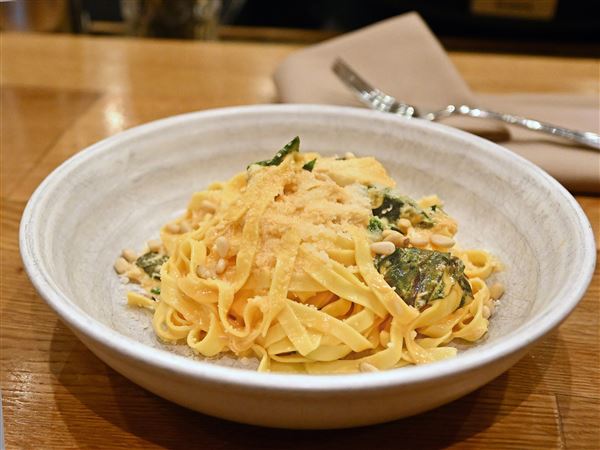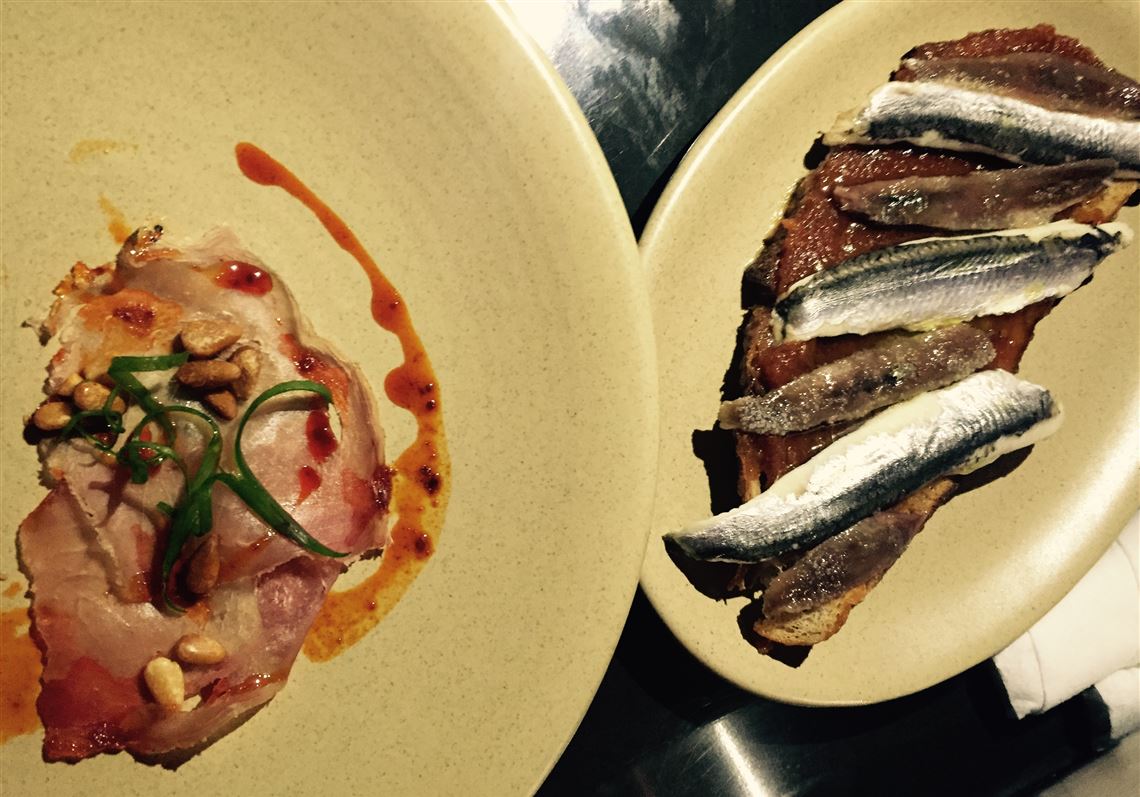Some restaurants make us nostalgic with familiar service, traditional dishes and modest decor. Others point to the future, not in the futuristic sense with iPad menus or drones serving dinner. Instead they highlight a city’s growth and change.
Morcilla in Lawrenceville shows ambition in a city on the rise. This can be delicious.
And beginning Feb. 6, Morcilla will serve lunch on the weekends as well as dinner, six days a week.
Lawrenceville
412-652-9924
- Hours: Wednesday through Monday 5 p.m. to close; Saturday and Sunday lunch 11 a.m. to 2 p.m.
- Basics: Morcilla is an exciting restaurant serving pintxos to platters rooted in traditional Spanish dishes.
- Dishes: Bacalao en aceite; cecina; jamon Iberico de Bellota; matrimonio; morcilla; oxtail; castanas; pigs feet and cheeks; pulpo; padrone peppers; bacalao; cordero en mereno; embutidos.
- Prices: Pintxos $5-$32; montaditos $4-$6; croquetas $5-$6; plates $7-$24; platters $27-$85.
- Summary: Credit cards, street parking, reservations, wheelchair-accessible.
- Noise level: Moderately loud.
Justin Severino and wife Hilary Prescott Severino, his partner and director of operations, bring the spirit of casual Spanish dining to Pittsburgh. In an era of themed restaurants and high-design concepts, Morcilla (pronounced Mor-SEE-a) has a hint of that, but overall it feels more personal.
For their second restaurant, following Cure, also in Lawrenceville, the couple convey their love for Spanish culture and cuisine through the design of the restaurant, the simplicity of the menu and a thoughtful wine and cocktail list.
It’s also very of-the-moment, courtesy of Mitre Box, a newish design firm started by Mr. Severino’s longtime friend Brandon Masi. Another friend of the Severinos, Sam DiBattista of Vivo in Sewickley, designed the tables and chandeliers, as well as the bathroom sinks (just trust me and visit the restroom).
At the bar, look up to find cured hams hanging from a ceiling rack, a reminder of what’s near and dear to Mr. Severino’s heart. He has built his reputation on cured meats, not just with locals, but also nationally, having landed on the semi-finalist list for the James Beard awards and People’s Choice for the best new chef in Food & Wine magazine.
No, your server isn’t going to haul one of those hams down from the ceiling to feed you. Instead, look across to the ham stand, where there’s a beautiful specimen that stands out against the blue-green tile.
That’s the jamon Iberico de Bellota ($25), cured for 36 months. The heritage breed is prized for its lineage, enriched with an acorn diet — and the details make all the difference. Each serving is paper thin, soft and almost buttery. It is a luxury indeed.
That jamon falls among the pintxos, the smallest plates, and montaditos, the little sandwiches on the menu. Both sections are just fine for grazing at the bar. By the way, there are no seats here. I love it, but I can see how the standing bar isn’t for everyone. Mr. Severino said it confuses first-timers, although during a recent visit to the bar, I saw a handful of customers standing around slurping raw oysters, an indication that it’s clearly catching on.
My favorite seafood here is the matrimonio ($4). The clean, bright anchovy and boquerones are served on toast with tomato conserva and lemon oil. Sometimes Mr. Severino runs out of the imported fish, but they’re back on the menu for now.
You must also try the morcilla ($4), the restaurant’s namesake, a beautiful word and a sublime tasting blood sausage. And the pigs feet and cheeks ($5) is a lusty dish, served with saffron aioli, smoked maple and pickled greens.
Even if you think you’re not into cider, order one. You will like it. As a matter of fact, you can drink several because they’re low-octane, yet light and dry, with a hint of sweetness. There’s a story behind the cider. The tap was made for the restaurant by the Trabancos, of the famous cider family in Gijon, near Oviedo, Spain. There are only two in the U.S.
After a spectacular afternoon touring the area and visiting the cidery during their trip to Spain last year, the Severinos had asked about the tap because, as they discovered, how the cider is poured adds effervescence and makes it taste better. Several months later, they received one as a gift.
“We hope you keep our cider on this tap,” the Trabancos said. With the cider recently available in the U.S., that’s the plan at Morcilla.
Regarding the other drinks, the Severinos said they’re surprised by the brisk sales of wine and sherries, like the ruby-red, bone-dry Tempranillo rose, or the pale Fino sherry. Their short, curated wine list is on-point, with maybe just over 20 selections by the glass or bottle.
Those who would rather sit can make a reservation in the 50-plus-seat dining room.
In this case, once the hostess takes coats and you’ve made yourself comfortable, consider the plates section of the menu, such as the house-cured bacalao ($6), a dish inspired by the variations of the cured fish the chef tried on his last trip.
A local version of salt cod can be found at Penn Mac in the Strip, especially during the holidays, where customers buy it then soak it for three days before preparation.
Mr. Severino is one of the few chefs in the area who cures his own, using the thickest part of sablefish from Massachusetts. Although bacalao is an ingredient in a croqueta, the plate is my favorite version, a simple dish served with espelette pepper and lemon honey.
Some variations of octopus — pulpo ($13) — have made their way onto Pittsburgh menus. It’s great here, served with a potato and olive oil espuma and a hit of acid with lime and cilantro jus. The lamb meatballs are good for sharing, the cordero en moreno ($10) with sumac seasoned yogurt, golden raisins and leeks.
Among other plates, the padron peppers ($7) are easy for snacking, followed by puerro a la plancha ($9), leeks dressed in a thick slather of pumpkin romesco. These dishes deliver big flavors.
Speaking of big, don’t overlook the platters, appropriate servings for two or four. The cochinillo ($85) for four is the clear winner, a crispy-skin suckling pig roast, a startling presentation with plenty of accoutrements like vegetable escabeche. But it is a commitment, especially if you have already started snacking at the bar.
The pollo ($31) can be tempting, a juicy half chicken served atop sunchokes and dressed with salsa verde. But the presentation can be a bit too Jackson Pollock, and the consistency of the sunchokes range from just cooked to loose, which isn’t terribly pleasant to eat. The other menu item I’d skip is the almejas y garbanzos ($14). Chickpeas muddle the clams in a disunified dish.
The only hesitation I have about recommending Morcilla for everyone is that diners who order a ton of dishes may be shocked by the final tally. My advice is to decide how hungry you are and figure out a strategy before ordering. This may require that you ask to look at both the bar and table menus when you arrive.
Also, it can be noisy, which may not bother the young or seasoned diners. But some customers may wish for more intimacy or a more pampering environment.
Morcilla is an interesting barometer of where we are now in terms of dining. It’s an example of how diners are willing to be educated by a celebrated chef — particularly when it comes to meat — and how international travel can influence the cravings of an up-and-coming city. It also reinforces Pittsburgh as a place of opportunity for those with experience, capital and imagination.
Melissa McCart: 412-263-1198 or on Twitter @melissamccart.
First Published: January 27, 2016, 5:00 p.m.





















